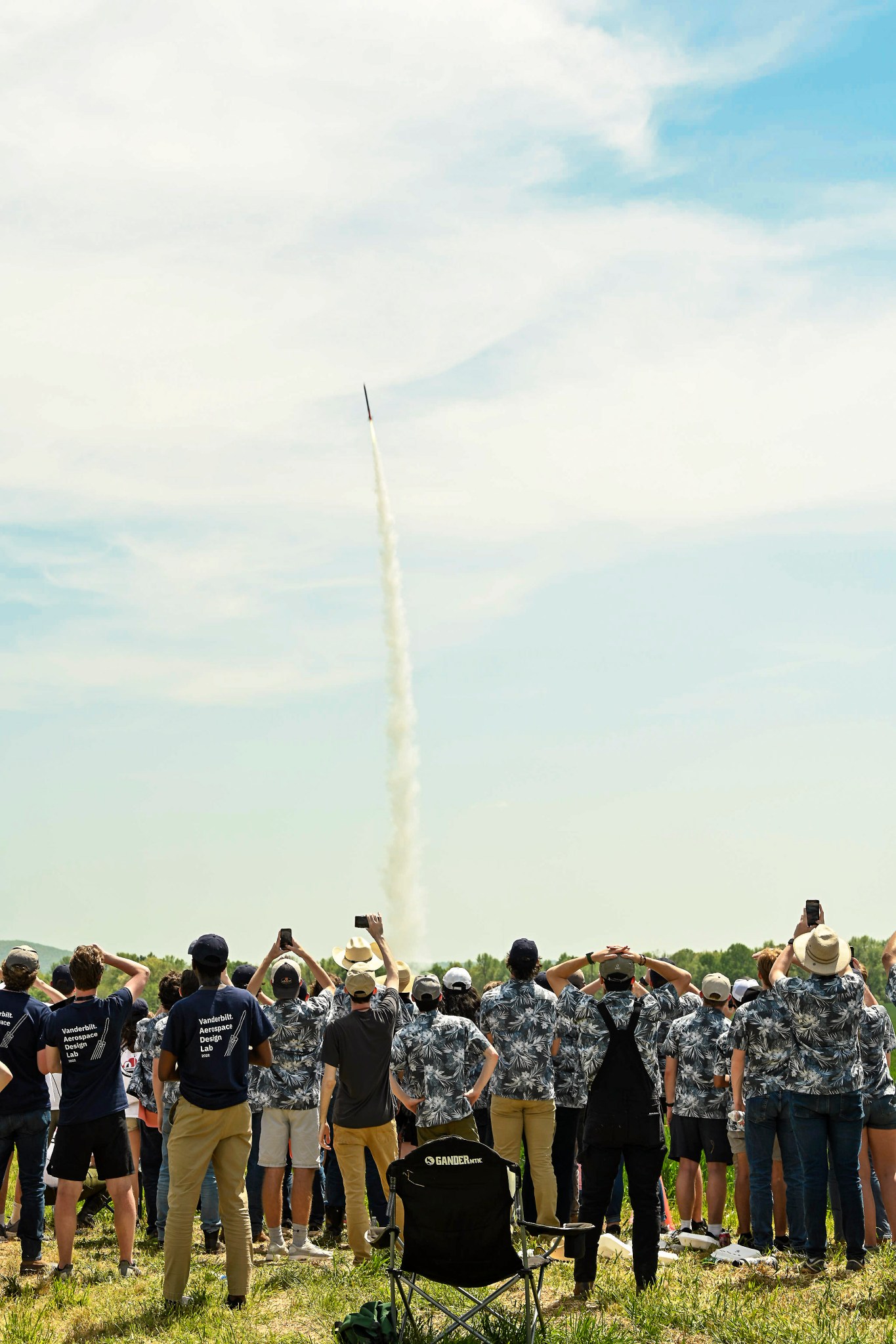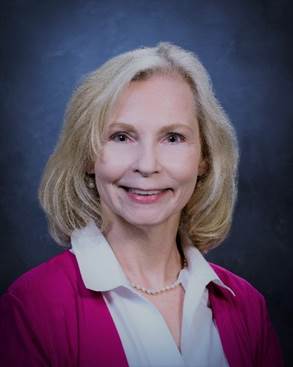In This Week’s Star
- Liftoff! Crew-5 Flight Crew Soars into the Florida Afternoon Sky
- Demolition Work Continues on Marshall Administrative Buildings; 4200 Complex to Close Oct. 21-31 for Safety Preparations
- Teams Confirm No Damage to Flight Hardware, Focus on November for Launch
- NASA Announces Teams for the 2023 Student Launch Challenge
- Federal Employee Viewpoint Survey Marks Record Response at Marshall
- Research Scientist Patrick Duran has Surprising Hobbies
- Stennis Begins Work on Key Testing Component
- Artemis II Rocket Engines Arrive at Michoud Assembly Facility
- Webb, Hubble Capture Detailed Views of DART Impact
- Crescent Moon Over the Crescent City
Liftoff! Crew-5 Flight Crew Soars into the Florida Afternoon Sky
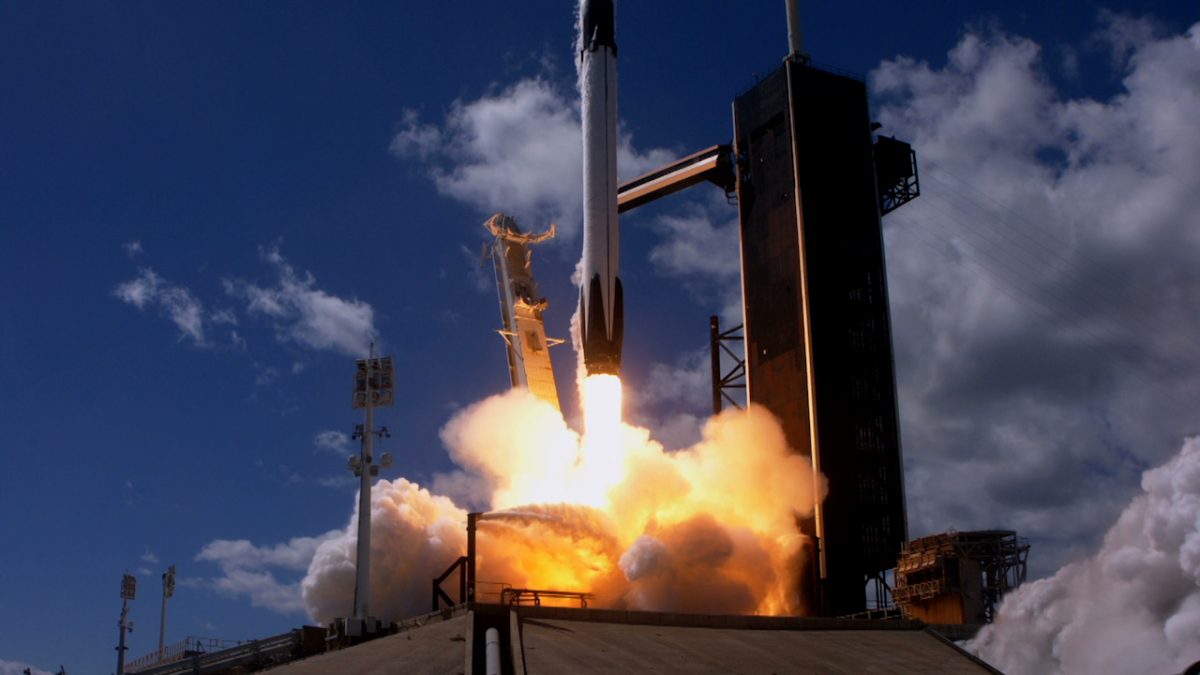
NASA’s SpaceX Crew-5 mission lifts off from Kennedy Space Center’s Launch Complex 39A at 11 a.m. CDT on Oct. 5. Nicole Aunapu Mann, Josh Cassada, Koichi Wakata, and Anna Kikina successfully started their approximate 22-hour journey to the International Space Station on NASA’s SpaceX Crew-5 mission. Details about the mission and NASA’s Commercial Crew Program can be found by following the Crew-5 blog, the commercial crew blog, @commercial_crew on Twitter, and commercial crew on Facebook. The Commercial Crew Program support team at NASA’s Marshall Space Flight Center continues contributing to commercial crew missions, including the Crew-5 mission. Consisting of about 80 people supporting the CCP office, Engineering, and Safety Mission Assurance, Marshall team members provide management support as well as engineering expertise in propulsion, valves and pyrotechnics, natural environments, and vehicle structures, among others. (NASA)
Demolition Work Continues on Marshall Administrative Buildings; 4200 Complex to Close Oct. 21-31 for Safety Preparations
By Rick Smith
The landscape of NASA’s Marshall Space Flight Center is changing – even as its team members once again help push the space frontier outward.
Demolition work is underway on Building 4201, part of the Marshall administrative complex situated off Rideout Road on Redstone Arsenal.
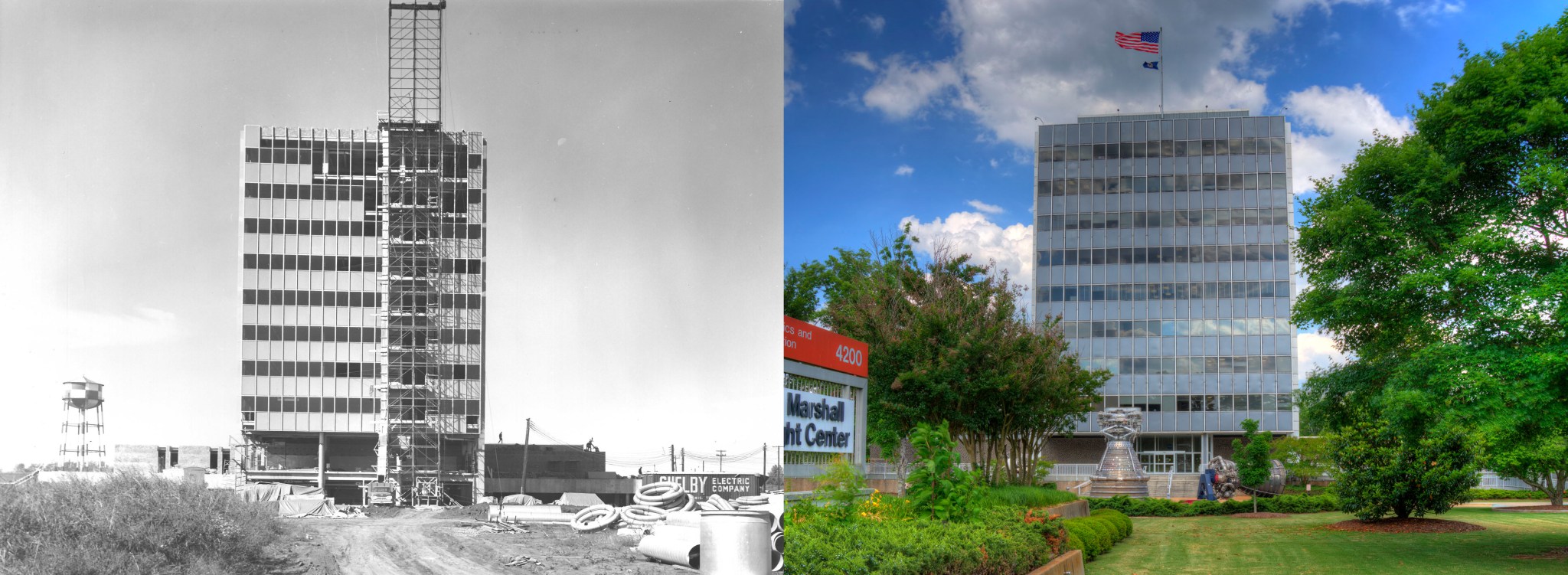
ARS Aleut Remediation of Oak Ridge, Tennessee, began the physical teardown phase Sept. 20. The structure is the latest Marshall facility to undergo demolition, owing to its age and the costly upkeep of its outdated electrical system, plumbing, and other utilities.
But it’s not alone. Building 4200, Marshall’s primary administrative offices from 1963-2020, also is on schedule for demolition Oct. 29. That more complex job, involving a controlled implosion of the 10-story building, will be handled by Target Contractors of Ladson, South Carolina. Target currently is preparing the site for demolition.
NASA erected buildings 4200 and 4201 in the early 1960s, seeking to expedite development of a rocket powerful enough to loft crewed Apollo missions to the Moon. The Saturn V, the vehicle which enabled those unprecedented missions of discovery, was developed and managed here, with numerous elements built and tested at sites across Redstone Arsenal, and shaped Marshall’s continuing role as a world-class resource for NASA propulsion systems, space hardware, and scientific endeavors.
Megan Vansant, the facilities project manager overseeing the demolition of 4200 and 4201, said the jobs call for different tactics. Building 4201 is being dismantled piece by piece, using excavators and other large construction equipment, whereas 4200 will involve a controlled implosion of the entire facility.
“That’s purely a matter of safety and efficiency,” she said. “Six stories is right at the limit for high-reach excavators. It’s much more cost-effective to implode 4200, reducing total man-hours involved.” That approach also keeps crews safer on the ground, she noted, not just during implosion but as they clear and haul away the debris pile.
Like its sister structure, Building 4200 had been in line for demolition or refurbishment as part of NASA’s “repair-by-replacement” tactic – tearing down costly, aging structures and replacing them with energy-efficient new facilities. Then in 2020, engineers identified structural issues in the administrative building’s exterior wall panels. Compounded by its age and the prohibitive cost of repairing and maintaining it, NASA decided to speed up the timetable and deactivate and demolish the structure now.
Preparing 4200 for implosion will require contractors to shut down the entire administrative complex beginning Oct. 21 at 5 p.m. to rig explosives and conduct site safety testing. The site will remain closed through demolition and for two days afterward, reopening Tuesday, Nov. 1. Demolition teams will halt work on Building 4201 during that period. Marshall team members quartered in buildings 4203, 4220, and 4221 will be required to work remotely Oct. 22-31. Access roads and parking lots will be closed, and all door readers in those buildings will be disabled.
The 4200 and 4201 demolition projects are being executed through the U.S. Army Corps of Engineers Facilities Reduction Program.
Smith, a Manufacturing Technical Solutions employee, supports Marshall’s Office of Strategic Analysis & Communications.
Teams Confirm No Damage to Flight Hardware, Focus on November for Launch
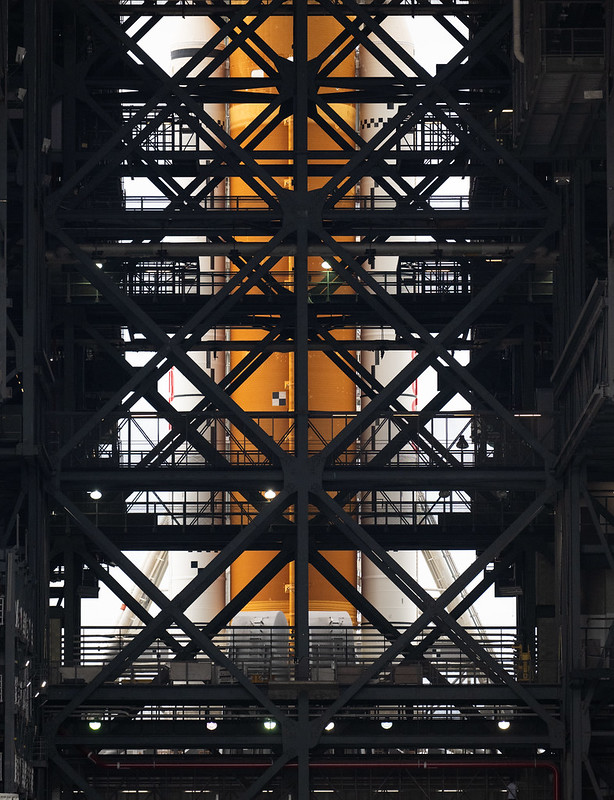
NASA’s Space Launch System (SLS) rocket with the Orion spacecraft aboard is seen atop the mobile launcher as it is rolled back to the Vehicle Assembly Building (VAB) from Launch Pad 39B on Sept. 29 at NASA’s Kennedy Space Center. NASA made the decision to roll back based on weather predictions associated with Hurricane Ian. Teams at Kennedy conducted initial inspections Sept. 30 to assess potential impacts from Hurricane Ian. There was no damage to Artemis flight hardware, and facilities are in good shape with only minor water intrusion identified in a few locations. Next, engineers will extend access platforms around the Space Launch System rocket and Orion spacecraft inside the VAB to prepare for additional inspections and start preparation for the next launch attempt, including retesting the flight termination system. As teams complete post-storm recovery operations, NASA has determined it will focus Artemis I launch planning efforts on the launch period that opens Nov. 12 and closes Nov. 27. Over the coming days, managers will assess the scope of work to perform while in the VAB and identify a specific date for the next launch attempt. Focusing efforts on the November launch period allows time for employees at Kennedy to address the needs of their families and homes after the storm and for teams to identify additional checkouts needed before returning to the pad for launch. Check the Artemis I blog for updates. NASA’s Artemis I mission is the first integrated test of the agency’s deep space exploration systems: the Orion spacecraft, SLS rocket, and supporting ground systems. (NASA/Joel Kowsky)
NASA Announces Teams for the 2023 Student Launch Challenge
NASA has announced the 69 student teams representing 25 states and Puerto Rico selected to compete in the 2023 Student Launch Challenge.
The annual competition – one of NASA’s Artemis Student Challenges – requires middle/high school and college/university students to design, build, and fly a high-powered amateur rocket and scientific payload to an altitude between 4,000 and 6,000 feet.
The nine-month-long challenge will culminate with an on-site launch event near NASA’s Marshall Space Flight Center on April 13-15, 2023. Teams are not required to travel for their final launch, having the option to launch from a qualified location in their hometown – details are outlined in the Student Launch Handbook.
Each year, NASA updates the payload challenge to mirror technologies needed for existing missions. This year, students must design a payload capable of autonomously receiving commands via radio frequency and completing a series of tasks with an on-board camera. While university/college division teams are required to meet the 2023 payload requirements, the middle/high school division teams have the option to take on the same challenge or design a payload experiment of their own.
Early in the launch season, students must declare a targeted altitude for their rocket on final launch day. The team closest to their prediction will win the Altitude Award. Additional awards are presented to deserving teams at the end of the competition including for vehicle design, experiment design, social media presence, and more.
Along with building a complex rocket and payload, students must undergo detailed reviews and evaluations, maintain social media platforms, and conduct outreach programs to educate local communities. These tasks encompass many foundational aspects of an aerospace organization and ensure students experience the wide array of diverse skills needed to build and maximize the benefits of spaceflight technology.
“This competition has the potential to transform students into well-qualified professionals for the modern-day workplace,” said Fred Kepner, activity lead for Student Launch at Marshall. “Many former students now work with NASA or our industry partners across the nation, some supporting the next chapter of space exploration, the Artemis program.”
Through Artemis, NASA will land the first woman and person of color on the Moon and eventually establish a permanent human-presence on the Moon. The success of the Artemis program relies on innovative technologies, fresh perspectives, and collaboration, which are foundational components of the Student Launch challenge.
Student Launch is managed by NASA’s Office of STEM Engagement at Marshall. Additional funding and support are provided by NASA’s Office of STEM Engagement’s Next Gen STEM project, NASA’s Space Operations Mission Directorate, Northrup Grumman, National Space Club Huntsville, American Institute of Aeronautics and Astronautics, National Association of Rocketry, Relativity Space, Bastion Technologies, and Siemens Digital Industries Software.
Federal Employee Viewpoint Survey Marks Record Response at Marshall
By Rick Smith
For an unprecedented 10 straight years, 2012-2021, NASA has been ranked as the Best Place to Work in the Federal Government among large agencies. Early findings in the latest Federal Employee Viewpoint Survey suggest that trend could continue in 2022 – and leaders at NASA and the agency’s Marshall Space Flight Center are already poring over the data to further improve workflows, morale, and productivity agencywide.
Part of the annual government-wide survey administered by the Office of Personnel Management in Washington, the employee survey is open to all full-time and part-time civil servants. It is designed to provide administrators with insight about employee satisfaction – and gives team members an important platform to suggest ways to improve workplace culture, conditions, and efficiency across the federal government.
A record 73% of Marshall civil servants responded to the survey this summer. The response rate improved agencywide, with every center reporting a response rate greater than 69%.
“The FEVS survey is a critical way we receive feedback from our employees about making Marshall a better place to work, so I was so pleased to see our participation rate at an all-time high,” said Marshall Center Director Jody Singer. She went on to note that “clarity and transparency of communications and the overall effectiveness of Marshall leadership” continue to be of critical importance to the health of the center.
“The Marshall leadership team takes these results seriously, and we continue to use them as a key data point in developing all employee engagement plans and activities,” she said.
Susan Whitfield, director of human resources in Marshall’s Office of Human Capital, agreed. “The feedback from employees helps us better understand workplace conditions from their viewpoint – the most important vantage point,” she said. “The survey aids Marshall leadership in effectively applying center resources and sustaining our collective enthusiasm and expertise as we pursue the work of the nation’s space program.”
Created and first administered by the Office of Personnel Management in 2002, the Federal Employee Viewpoint Survey has been conducted annually since 2010. In keeping with new directives by the White House and NASA Administrator Bill Nelson, revisions to the survey in 2021-22 strove to clarify its focus on Diversity, Equity, Inclusion and Accessibility programs. Marshall rated an 87.2% positive among survey respondents in that area in 2022.
A second new area of focus, the Performance Confidence Index, scrutinizes how effectively organizations can commit to new challenges, delivering on high-priority projects and flight missions – a crucial topic as NASA makes ready to send the first crewed Artemis rockets to the Moon, ushering in the next era of human space exploration. Among survey respondents, Marshall rated a stellar 95.5% positive in this category.
Further survey refinements more closely addressed workers’ relationships with their immediate supervisors – a result, Whitfield said, of COVID-19 pandemic protocols and subsequent return-to-work efforts.
“We have relied on front-line supervisors so much in terms of communicating with their teams and with center leadership during this difficult period,” she said. “It’s a unique challenge to manage a hybrid workforce, and to ensure that every team member, on-site or remote, feels like their career development, their contributions, and their well-being matter to their supervisors.”
Whitfield said such feedback played a big part in influencing the way Marshall and NASA have revised workflows and work environments over the last couple years.
“The survey data remains a critical data point to help guide us,” she said. “We had to dramatically alter processes to keep our team members safe, though it may not have been the optimal way to get our work done,” she said. “We remain an engineering-centric organization, after all, and though a lot of our work is done on computer screens, there are still wrenches to turn and physical hardware and systems to test and deliver.”
That fact required a fresh approach to logistics, workflows, and team morale throughout the COVID-19 crisis, she said.
Results of the 2022 survey are being shared with managers and supervisors across Marshall, and Whitfield noted that Human Resource Business Partners in the Office of Human Capital are available to consult with their assigned organizations about the survey findings.
“We anticipate and hope that every supervisor will review the data and make use of it, planning activities to engage their groups, adapting new strategy plans, taking all the findings into account as they apply to each particular division or team,” Whitfield said.
The Office of Personnel Management in Washington is expected to make available its full findings – reflecting the civil servant inputs across the entire federal government – later this year. Will NASA take home its 11th consecutive honor as the best place to work in the federal government?
“Time will tell,” Whitfield said.
Smith, a Manufacturing Technical Solutions employee, supports Marshall’s Office of Strategic Analysis & Communications.
Research Scientist Patrick Duran has Surprising Hobbies
(This is the third in a series of profiles on early career scientists in the Earth Science Branch at NASA’s Marshall Space Flight Center.)
By Dauna Coulter
Every Tuesday evening, you’ll find research scientist Patrick Duran working a stand at the local produce market. He and his wife market the bounty from their mini farm there.
“We grow all kinds of fruits and vegetables, and raise free-range chickens and pigs, selling both meat and eggs,” Duran said.
He was born and raised in Fruit Cove, Florida, which is about 30 miles south of Jacksonville. As a teenager, he made cast nets, hand-tying over 20,000 knots by hand.
That takes persistence. Duran has also been persistent with his interest in weather. Like many of his colleagues at NASA’s Marshall Space Flight Center, he became enamored with weather at an early age.
“As soon as I could read, I started reading weather books,” he said. “By age 6, I had read every kid’s weather book in the county library. In middle school, I read college textbooks about it.”
Duran earned his bachelor’s degree in meteorology from the Florida Institute of Technology in 2012 and his doctorate in atmospheric science from the University at Albany, State University of New York in 2018. He moved to Huntsville in 2018.
As the leader of the Short-term Prediction Research and Transition Center, or SPoRT, the center’s tropical meteorology research and applications team, Duran specializes in tropical cyclone dynamics. He studies how hurricanes form and intensify.
“The most exciting thing I’m researching is how to use lightning to predict hurricane intensity,” he said. “We’re looking at lightning from a novel perspective – using the brightness and size of lightning flashes to help determine whether the storm will intensify.”
Duran and his team also want to understand the outer rain bands in hurricanes.
“Some bands can move far from the center of a storm as a squall line and cause severe weather and tornadoes long before the storm center makes landfall,” he said. “We want to understand the physical processes that drive those rain bands so we can better model and track them.”
Duran seeks understanding of much more than storms.
“I want to better understand God and creation and allow this knowledge to reform me to better love my family and neighbors,” he said. “This philosophy has been developed over years of thought, prayer, reading, and struggle. I don’t always live up to this goal, but I try!”
Family has always been very important to him.
“My father taught me how to work hard to achieve my goals, showed me that what really matters in life is faith and family and to live a life of integrity,” he said.
Duran’s daughter and his wife are his pride and joy.
“My daughter is 18-months-old, and every time I see her learn something new it’s a whole new level of pride,” he said. “My wife is a huge support. She and my daughter bring me more joy than I could have imagined before they came into my life. I’m tremendously grateful for the life I’ve been given. Working at NASA is an honor, and I can’t think of a better place to spend my career.”
It hasn’t always been smooth sailing for this 31-year-old. Again, persistence saw him through.
“I struggled with some of my courses in college, especially the higher-level math,” he said. “It was just a matter of persevering, because as soon as I saw that same math related to the atmosphere, it all started to make sense to me. There was a time in college where my future in meteorology looked doubtful and I almost gave up, but I’m grateful I persevered through the challenge!”
As a recreational tree climber, Duran overcomes physical challenges.
“I use rope access techniques to climb trees, which has allowed me to climb some really huge, ancient cypress trees back home in Florida,” Duran said.
Onward and upward.
Coulter, a Media Fusion employee, supports Marshall’s Office of Strategic Analysis & Communications.
Stennis Begins Work on Key Testing Component
A critical component needed for future testing in support of NASA’s Artemis missions to the Moon and beyond recently arrived at the agency’s Stennis Space Center.
The interstage simulator special test equipment arrived at Stennis on Sept. 21 via barge from NASA’s Michoud Assembly Facility, where it was fabricated. The simulator, 31 feet in diameter and 33 feet tall, will be used during Green Run testing of the new Exploration Upper Stage (EUS). EUS will fly on future Space Launch System (SLS) missions as NASA continues its mission to explore the universe for the benefit of all.
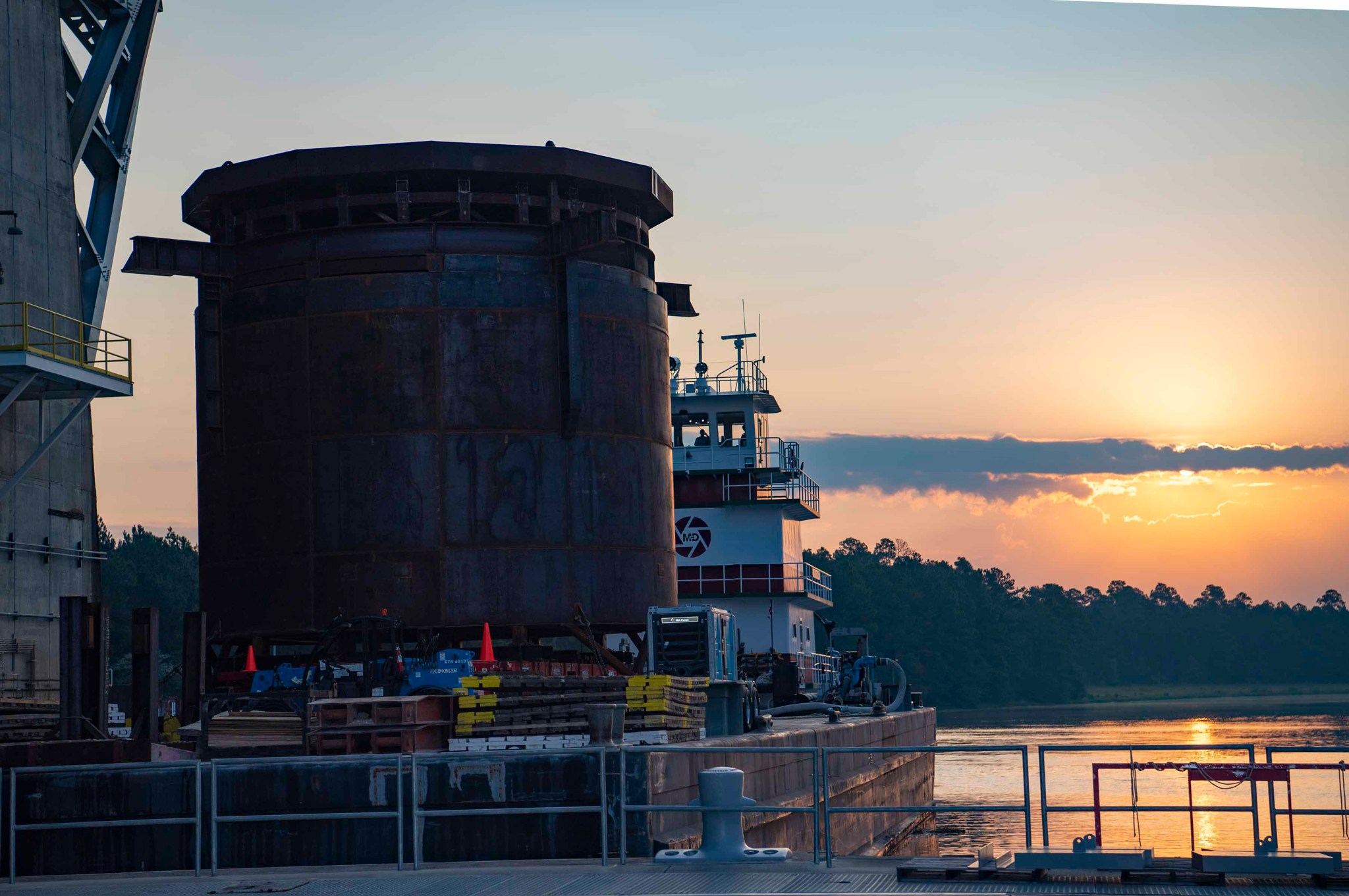
EUS is being built at Michoud as a more powerful second stage to send the Orion spacecraft to deep space. It will replace the interim cryogenic propulsion stage being used on initial Artemis flights and enable NASA to send astronauts and large payloads to the Moon on a single mission.
The new upper stage will be powered by four RL10 engines, generating a combined 97,360 pounds of thrust, compared to the single engine used on the interim stage. That will allow NASA to send 40% more payload to the Moon, 38 metric tons compared to 27 metric tons on initial missions.
EUS is expected to fly on the Artemis IV mission. Prior to that time, it will undergo Green Run testing on the B-2 Test Stand at Stennis, where the SLS core stage also was tested. During Green Run, NASA will conduct a series of tests on the EUS integrated systems to demonstrate it is ready to fly.
The interstage simulator recently delivered to Stennis is essential to enable the series of tests. The Green Run effort will culminate with a hot fire of the four RL10 engines, just as during an actual mission.
The interstage simulator will serve dual purposes. Most importantly, it will function much like the SLS interstage section to protect the lower part of the EUS vehicle from the environment, keeping the electrical and propulsion systems safe while at Stennis. The top portion of the simulator also will serve as a thrust takeout system to absorb the thrust of an EUS hot fire and transfer it back to the test stand.
In the coming months, the Stennis team will perform finishing work to prepare the simulator for installation on the test stand. This will include finishing access platforms and the precision interfaces prior to sandblasting and painting. The final step prior to installation will be installing various piping and tubing, as well as wiring connections needed for Green Run testing. “As NASA looks to gain a better understanding of the universe, important projects like this need to occur, …” explained Stennis Project Engineer Nick Nugent. “Stennis is on the front lines … with our rocket engine testing, our component testing, and then also our stage testing, like we did with the (SLS) core stage Green Run. It’s an exciting time to be here.”
Artemis II Rocket Engines Arrive at Michoud Assembly Facility
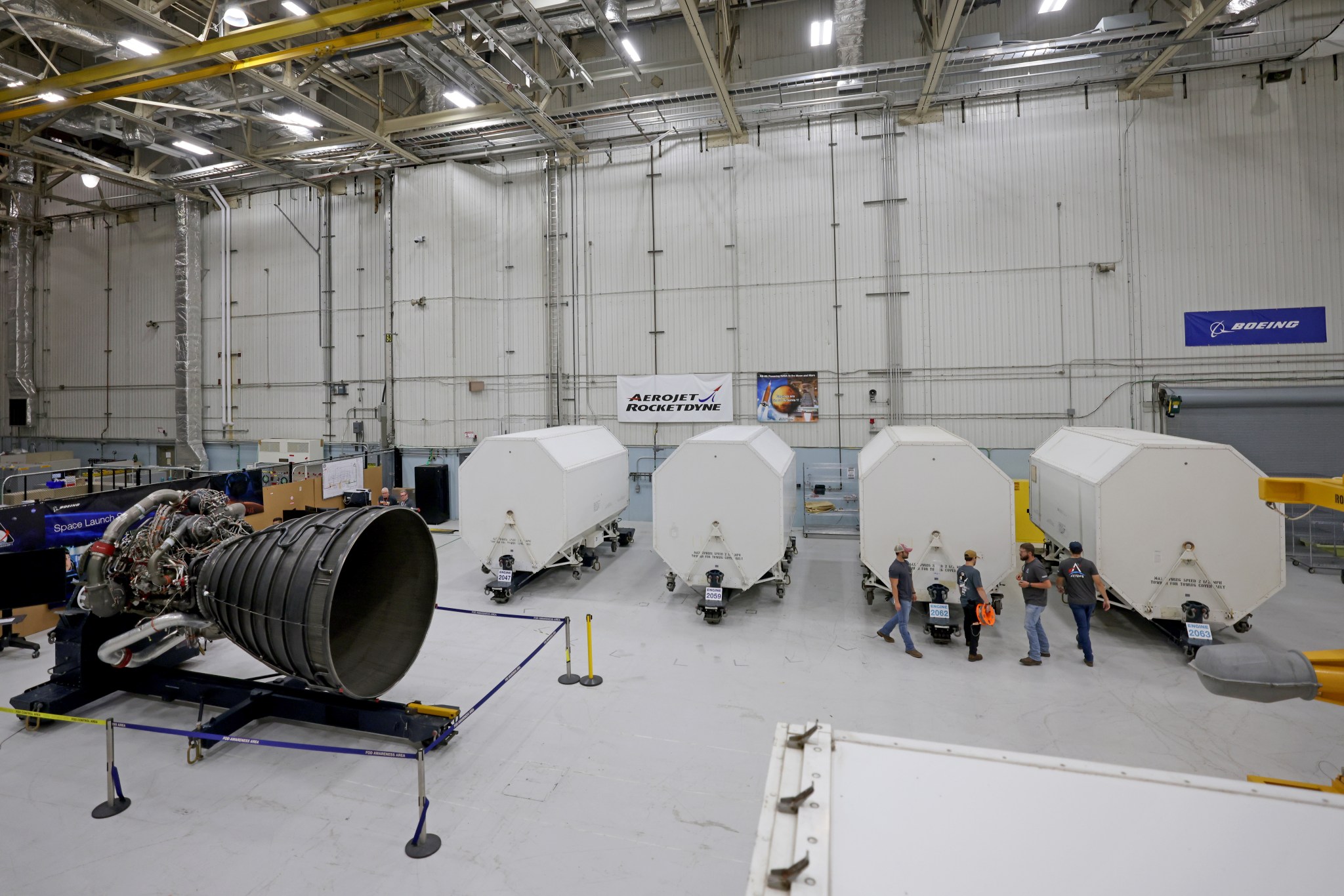
Together, the four RS-25 engines will produce more than 2 million pounds of thrust during ascent to help send Artemis II astronauts beyond Earth’s orbit to lunar orbit. Technicians from NASA and Aerojet Rocketdyne, the prime contractor for the engines, will store the engines at Michoud and prepare them for integration into the engine section at the bottom of the rocket’s 212-foot-tall core stage. They will use a pathfinder engine to practice the intricate process of installing each engine on the stage prior to installing the flight engines.
The first engine – Engine E2047 — of the flight set flew on 15 space shuttle missions, including the final shuttle mission STS-135. The second engine of the set – Engine E2059 — previously flew on five shuttle missions. The third and fourth engines – E2062 and E2063 – are new engines that include some previously flown hardware.
With the Artemis missions, NASA will land the first woman and the first person of color on the Moon and establish long-term exploration in preparation for missions to Mars. SLS and NASA’s Orion spacecraft, along with the commercial human landing system and the Gateway in orbit around the Moon, are NASA’s backbone for deep space exploration. SLS is the only rocket that can send Orion, astronauts, and supplies to the Moon in a single mission. Credits: NASA/ Michael DeMocker
Teams have delivered the four RS-25 engines that will help power Artemis II, the first crewed mission of NASA’s Artemis missions and second flight of the Space Launch System (SLS) rocket, to NASA’s Michoud Assembly Facility. Later this fall, the engines will be installed into the Artemis II core stage, which is in the final phase of assembly at Michoud where it was manufactured. Trucks transported the engines in special containers from NASA’s Stennis Space Center, where they were upgraded with new controllers. Together, the four RS-25 engines will produce more than 2 million pounds of thrust during ascent to help send Artemis II astronauts beyond Earth’s orbit to lunar orbit. Technicians from NASA and Aerojet Rocketdyne, the prime contractor for the engines, will store the engines at Michoud and prepare them for integration into the engine section at the bottom of the rocket’s 212-foot-tall core stage. They will use a pathfinder engine to practice the intricate process of installing each engine on the stage prior to installing the flight engines. The first engine – Engine E2047 – of the flight set flew on 15 space shuttle missions, including the final shuttle mission STS-135. The second engine of the set – Engine E2059 – previously flew on five shuttle missions. The third and fourth engines – E2062 and E2063 – are new engines that include some previously flown hardware. With the Artemis missions, NASA will land the first woman and the first person of color on the Moon and establish long-term exploration in preparation for missions to Mars. SLS and NASA’s Orion spacecraft, along with the commercial human landing system and the Gateway in orbit around the Moon, are NASA’s backbone for deep space exploration. SLS is the only rocket that can send Orion, astronauts, and supplies to the Moon in a single mission. (NASA/ Michael DeMocker)
Webb, Hubble Capture Detailed Views of DART Impact
Two of NASA’s Great Observatories, the James Webb Space Telescope and the Hubble Space Telescope, have captured views of a unique NASA experiment designed to intentionally smash a spacecraft into a small asteroid in the world’s first-ever in-space test for planetary defense. These observations of NASA’s Double Asteroid Redirection Test (DART) impact mark the first time that Webb and Hubble simultaneously observed the same celestial target.
On Sept. 26, at 6:14 pm CDT, DART intentionally crashed into Dimorphos, the asteroid moonlet in the double-asteroid system of Didymos. It was the world’s first test of the kinetic impact mitigation technique, using a spacecraft to deflect an asteroid that poses no threat to Earth, and modifying the object’s orbit. DART is a test for defending Earth against potential asteroid or comet hazards.
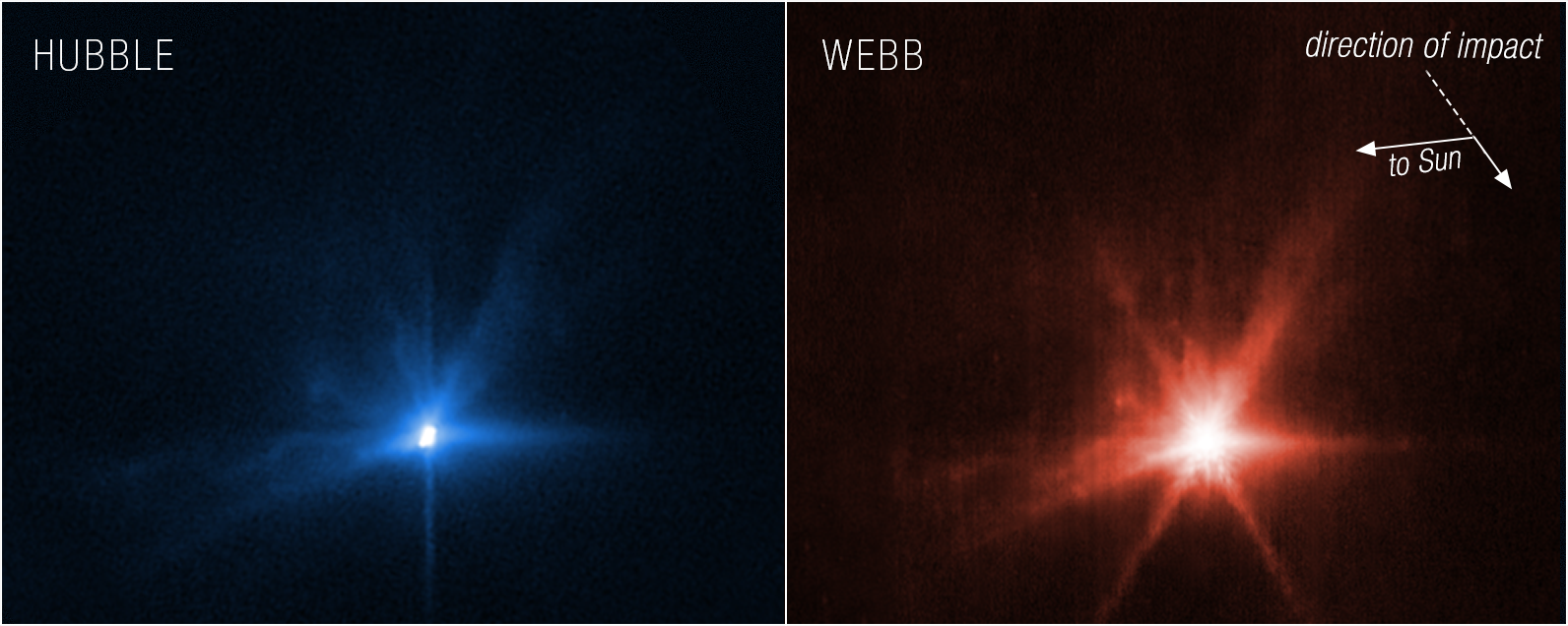
These images, Hubble on left and Webb on the right, show observations of the Didymos-Dimorphos system several hours after NASA’s Double Asteroid Redirection Test (DART) intentionally impacted the moonlet asteroid. It was the world’s first test of the kinetic impact technique using a spacecraft to deflect an asteroid by modifying its orbit.
Both Webb and Hubble observed the asteroid before and after the collision took place.
Scientists will use the combined observations from Hubble and Webb to gain knowledge about the nature of the surface of Dimorphos, how much material was ejected by the collision, how fast it was ejected, and the distribution of particle sizes in the expanding dust cloud.
In the coming months, scientists will also use Webb’s Mid-Infrared Instrument (MIRI) and Near-Infrared Spectrograph (NIRSpec) to observe ejecta from Dimorphos further. Spectroscopic data will provide researchers with insight into the asteroid’s composition. Hubble will monitor Dimorphos ten more times over the next three weeks to monitor how the ejecta cloud expands and fades over time.
Hubble observations were conducted in one filter, WFC3/UVIS F350LP (assigned the color blue), while Webb observed at F070W (0.7 microns, assigned the color red).
NIRCam was built by a team at the University of Arizona and Lockheed Martin’s Advanced Technology Center. Credits: Science: NASA, ESA, CSA, Jian-Yang Li (PSI), Cristina Thomas (Northern Arizona University), Ian Wong (NASA-GSFC); image processing: Joseph DePasquale (STScI), Alyssa Pagan (STScI)
The coordinated Hubble and Webb observations are more than just an operational milestone for each telescope – there are also key science questions relating to the makeup and history of our solar system that researchers can explore when combining the capabilities of these observatories.
“Webb and Hubble show what we’ve always known to be true at NASA: We learn more when we work together,” said NASA Administrator Bill Nelson. “For the first time, Webb and Hubble have simultaneously captured imagery from the same target in the cosmos: an asteroid that was impacted by a spacecraft after a seven-million-mile journey. All of humanity eagerly awaits the discoveries to come from Webb, Hubble, and our ground-based telescopes – about the DART mission and beyond.”
Observations from Webb and Hubble together will allow scientists to gain knowledge about the nature of the surface of Dimorphos, how much material was ejected by the collision, and how fast it was ejected. Additionally, Webb and Hubble captured the impact in different wavelengths of light – Webb in infrared and Hubble in visible. Observing the impact across a wide array of wavelengths will reveal the distribution of particle sizes in the expanding dust cloud, helping to determine whether it threw off lots of big chunks or mostly fine dust. Combining this information, along with ground-based telescope observations, will help scientists to understand how effectively a kinetic impact can modify an asteroid’s orbit.
Webb took one observation of the impact location before the collision took place, then several observations over the next few hours. Images from Webb’s Near-Infrared Camera (NIRCam) show a tight, compact core, with plumes of material appearing as wisps streaming away from the center of where the impact took place.
Observing the impact with Webb presented the flight operations, planning, and science teams with unique challenges, because of the asteroid’s speed of travel across the sky. As DART approached its target, the teams performed additional work in the weeks leading up to the impact to enable and test a method of tracking asteroids moving over three times faster than the original speed limit set for Webb.
“I have nothing but tremendous admiration for the Webb Mission Operations folks that made this a reality,” said principal investigator Cristina Thomas of Northern Arizona University in Flagstaff, Arizona. “We have been planning these observations for years, then in detail for weeks, and I’m tremendously happy this has come to fruition.”
Scientists also plan to observe the asteroid system in the coming months using Webb’s Mid-Infrared Instrument (MIRI) and Webb’s Near-Infrared Spectrograph (NIRSpec). Spectroscopic data will provide researchers with insight into the asteroid’s chemical composition.
Webb observed the impact over five hours total and captured 10 images. The data was collected as part of Webb’s Cycle 1 Guaranteed Time Observation Program 1245 led by Heidi Hammel of the Association of Universities for Research in Astronomy.
Hubble also captured observations of the binary system ahead of the impact, then again 15 minutes after DART hit the surface of Dimorphos. Images from Hubble’s Wide Field Camera 3 show the impact in visible light. Ejecta from the impact appear as rays stretching out from the body of the asteroid. The bolder, fanned-out spike of ejecta to the left of the asteroid is in the general direction from which DART approached.
Some of the rays appear to be curved slightly, but astronomers need to take a closer look to determine what this could mean. In the Hubble images, astronomers estimate that the brightness of the system increased by three times after impact, and saw that brightness hold steady, even eight hours after impact.
Hubble plans to monitor the Didymos-Dimorphos system 10 more times over the next three weeks. These regular, relatively long-term observations as the ejecta cloud expands and fades over time will paint a more complete picture of the cloud’s expansion from the ejection to its disappearance.
“When I saw the data, I was literally speechless, stunned by the amazing detail of the ejecta that Hubble captured,” said Jian-Yang Li of the Planetary Science Institute in Tucson, Arizona, who led the Hubble observations. “I feel lucky to witness this moment and be part of the team that made this happen.”
Hubble captured 45 images in the time immediately before and following DART’s impact with Dimorphos. The Hubble data was collected as part of Cycle 29 General Observers Program 16674.
“This is an unprecedented view of an unprecedented event,” summarized Andy Rivkin, DART investigation team lead of the Johns Hopkins University Applied Physics Laboratory in Laurel, Maryland.
Johns Hopkins APL manages the DART mission for NASA’s Planetary Defense Coordination Office as a project of the agency’s Planetary Missions Program Office, which is at NASA’s Marshall Space Flight Center.
Crescent Moon Over the Crescent City
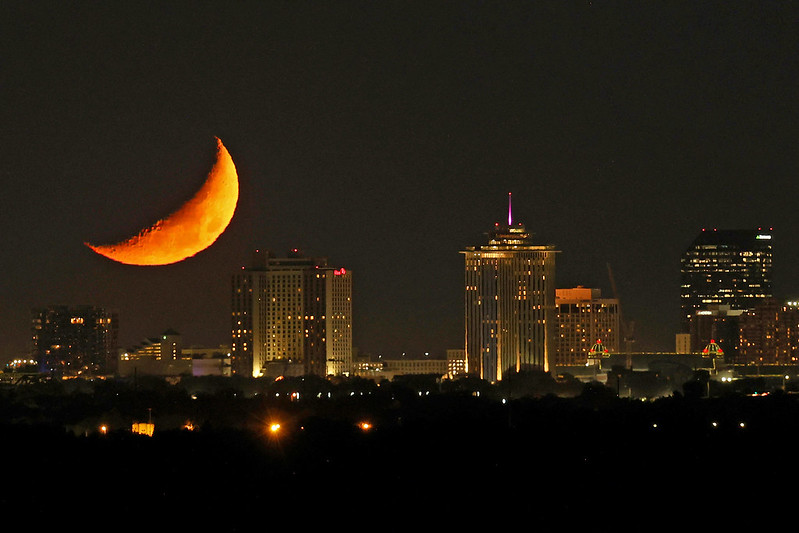
A crescent moon sets over the Crescent City in a photo shot from near NASA’s Michoud Assembly Facility in New Orleans on Sept. 30, the night before International Observe the Moon Night on Oct. 1. International Observe the Moon Night is sponsored by NASA’s Lunar Reconnaissance Orbiter mission and the Solar System Exploration Division at NASA’s Goddard Space Flight Center, with many contributors. The goals of the event include raising awareness of NASA’s lunar science and exploration programs. For more about International Observe the Moon Night, visit here. (NASA/Michael DeMocker)


























